Business
Priorities in Focus: Will Budget 2025 address Sri Lanka’s agricultural challenges?
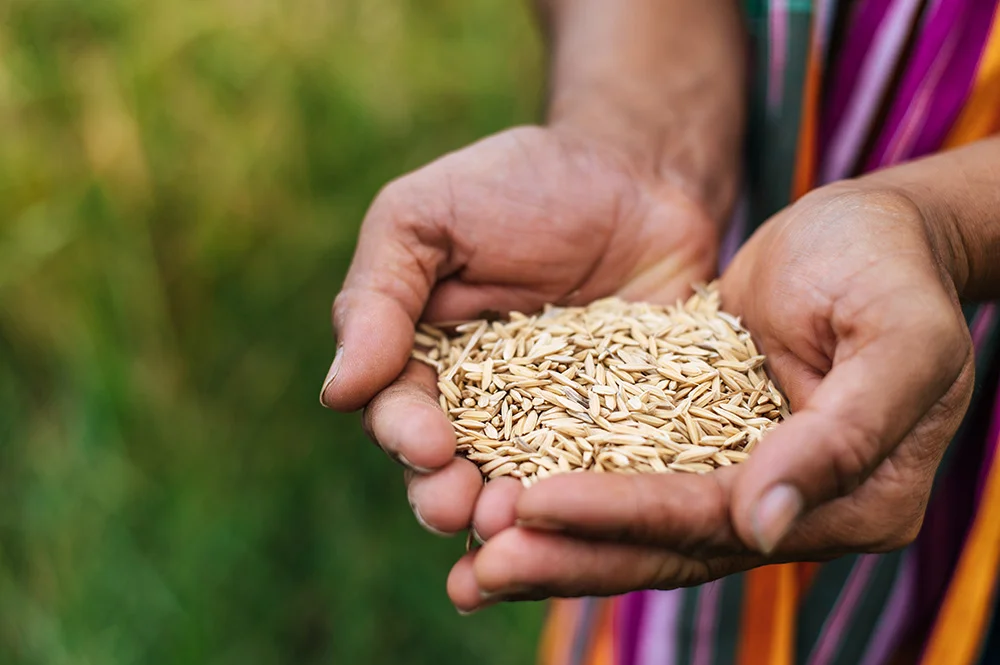
Manoj Thibbotuwawa is a Research Fellow at the Institute of Policy Studies of Sri Lanka (IPS) with
research interests in agriculture, agribusiness value chains, food security, climate change and environmental and natural resource economics. He has more than 19 years of research experience at IPS. . Dr Thibbotuwawa holds a BSc (Agriculture) with Honours from the University of Peradeniya, an MSc (Agricultural Economics) from the Post-Graduate Institute of Agriculture at the University of Peradeniya, and a PhD from the University of Western Australia. He has also obtained a Post-Graduate Diploma in Modelling and Accounting for Sustainable Development from the International Institute of Social Studies (ISS) in The Hague. Dr Thibbotuwawa is a recipient of the prestigious Nuffic Fellowship from the Government of the Netherlands and the Endeavour Award from the Government of Australia.
Lakmini Fernando is a Research Fellow at IPS with primary research interest in Development Economics, Public Finance and Climate Change. She has expertise in econometric data analysis, research design and causal methodologies. Dr Fernando holds a BSc in Agriculture from the University of Peradeniya, a Master of Development Economics (Advanced) from the University of Queensland, Australia and a PhD in Economics from the University of Adelaide, Australia. She was awarded the Dean’s Honour Roll from the University of Queensland for Outstanding Academic Excellence in 2015 and the Dean’s Commendation for Doctoral Thesis Excellence from the University of Adelaide in 2021.
By Dr Manoj Thibbotuwawa and Dr Lakmini Fernando
Public expenditure on agriculture as a share of total government spending has decreased from 6.4% to 2% between 2014 and 2023.
The irrigation subsector receives most of the agricultural spending (41%), with subsidies accounting for a high 26%.
Change to funding priorities necessary to address critical concerns.
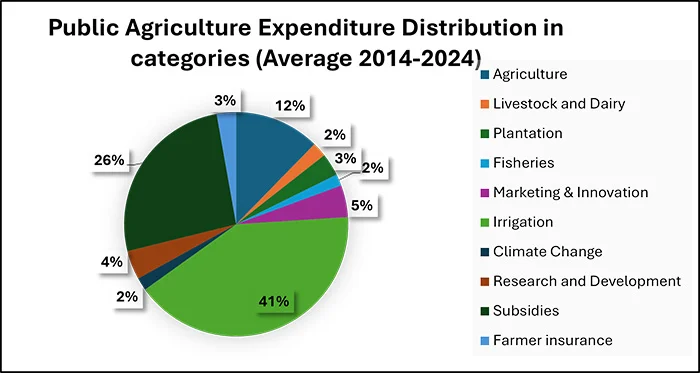 The agricultural sector in Sri Lanka has long been a pillar of the nation’s economy, yet its decline reflects a complex interplay of economic shifts, policy decisions, and underutilised potential. Agriculture’s contribution to the overall economy in Sri Lanka has gradually diminished over time, while the agricultural labour force has shrunk at a slower rate. This disparity between a declining sector and a stagnant workforce, coupled with the failure to address structural changes by improving land and labour productivity, has led to poor sector performance, particularly in terms of food security and farm income.
The agricultural sector in Sri Lanka has long been a pillar of the nation’s economy, yet its decline reflects a complex interplay of economic shifts, policy decisions, and underutilised potential. Agriculture’s contribution to the overall economy in Sri Lanka has gradually diminished over time, while the agricultural labour force has shrunk at a slower rate. This disparity between a declining sector and a stagnant workforce, coupled with the failure to address structural changes by improving land and labour productivity, has led to poor sector performance, particularly in terms of food security and farm income.
Additionally, unproductive public spending in the form of inefficient allocation, short-term concentration, and neglect of crucial areas is an important contributory factor. In this context, it is crucial to assess whether public expenditure allocation in Sri Lanka has undergone significant shifts aimed at unlocking the agriculture sector’s potential while advancing food security and fostering rural development.
Tracking the Shift: Trends in Public Spending on Agriculture
Over the last decade, Sri Lanka has struggled to spend adequately on agriculture due to competing fiscal concerns. Before COVID-19, total agricultural investment was around LKR 112 billion in real terms between 2014 and 2020. However, due to the impact of COVID-19, it sharply declined to LKR 88 billion in 2021. Since then, agricultural investment has slightly increased, averaging LKR 97 billion in the past two years (2022-2023). Despite an increase in absolute public expenditure on agriculture (PEA), both the GDP share and the percentage of the total budget allocated to agriculture have been declining.
PEA as a percentage of GDP has fallen from 1.1% in 2014 to 0.8% by 2023. Similarly, PEA as a percentage of total government spending has decreased from 6.4% to 2% throughout the same period. Notably, the balance between capital and recurring expenditures has shifted dramatically in favour of more recurrent expenditures during institutional structure changes linked to changes of government, as shown in 2015, 2019, and 2020.
Guiding the Budget: Who Shapes Agricultural Investments?
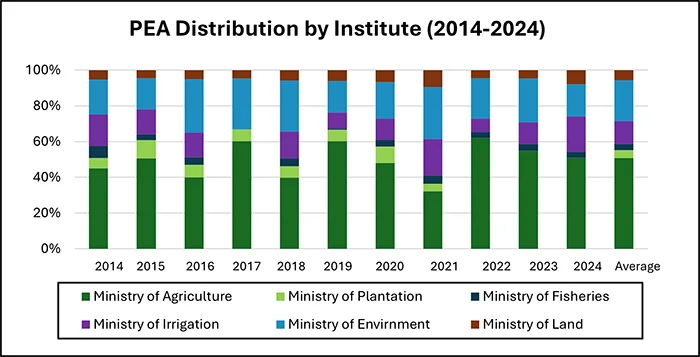 The agriculture sector in Sri Lanka is primarily managed by the Ministry of Agriculture (MOA), the Ministry of Plantation Industries (MOP) and the Ministry of Fisheries (MOF), as outlined in the Public Investment Programme (PIP). While the land and irrigation sectors are closely linked to agriculture, they fall under the jurisdiction of separate ministries: the Ministry of Lands (MOL) and the Ministry of Irrigation (MOI), respectively. In terms of budgetary allocations, MOA historically receives the largest share, accounting for 51% of agriculture-related expenditures.
The agriculture sector in Sri Lanka is primarily managed by the Ministry of Agriculture (MOA), the Ministry of Plantation Industries (MOP) and the Ministry of Fisheries (MOF), as outlined in the Public Investment Programme (PIP). While the land and irrigation sectors are closely linked to agriculture, they fall under the jurisdiction of separate ministries: the Ministry of Lands (MOL) and the Ministry of Irrigation (MOI), respectively. In terms of budgetary allocations, MOA historically receives the largest share, accounting for 51% of agriculture-related expenditures.
This is followed by the Ministry of Mahaweli Development and Environment (MOE) with 23%, and MOI with 13%. MOF and MOP receive smaller allocations, at 3% and 4% respectively. While the nominal PEA has been on the rise, real-term PEA has either declined or remained largely unchanged across all ministries.. However, this does not necessarily indicate whether agricultural expenditures are aligned with sectoral policies, making it challenging to evaluate the effectiveness of spending in addressing critical concerns within the sector.
Business
Janashakthi Life records over LKR 5 billion in profits for second consecutive year

Janashakthi Life, one of the fastest growing Life insurers in Sri Lanka has recorded a massive LKR 5.7 Billion Profit Before Tax for the period under review. This is the second consecutive year the company has surpassed the LKR 5 billion mark in PBT.
Reflecting on the company’s achievements, Ravi Liyanage, Director / CEO of Janashakthi Insurance PLC, said, “Our strong financial performance in 2024 is a testament to our strategic focus, operational excellence, and steadfast commitment to serving our policyholders. Despite market uncertainties, we have continued to grow, delivering exceptional value to our policyholders and all the stakeholders. Our exponential growth trajectory was double the size of the industry growth to reach 44% in revenue growth surpassing over LKR 6.6 Billion premium income whilst not compromising the value creation to our investors and shareholders recording over LKR 5.7 Billion PBT.
“Looking ahead, the company is well-poised to maintain its momentum as the fastest-growing insurance provider in 2025. The company has already deployed well focused strategies for market and distribution expansion in keeping with product / market as a matrix for growth. Some of the innovative products are being developed for emerging segments of the life insurance market in 2025. Further, plans are already in place to deliver best-in-class service through focused customer lifecycle management. The company is also executing robust digitalization initiatives to strengthen its position as a pioneer in digital innovation. Janashakthi Life’s total assets amount to LKR 38 billion at the close of 2024, reflecting robust growth. This underscores the financial strength and stability of the company, ensuring long-term security and sustainability for its stakeholders. Further, A key financial indicator, the Capital Adequacy Ratio of over 277%, highlights the company’s prudent financial management and reinforces confidence among all stakeholders”, added Liyanage.
Annika Senanayake, Chairperson of Janashakthi Insurance PLC, commented on the performance, “At Janashakthi Life, our resolute focus is on creating sustainable value for all stakeholders. Our performance in 2024 reflects not only our financial strength but also our deep commitment to supporting our policyholders when it matters most. The significant increase in claims paid denotes our dedication to being a reliable partner in our customers’ lives, providing them with financial security and peace of mind. As we look to the future, we are committed to invest in our human resource, technology, and product innovation to continue delivering customer-centric solutions, strengthening our market position, and driving long-term growth in Sri Lanka’s life insurance sector”.
“In 2024, we provided over LKR 4.2 billion in benefits to our policyholders through claims and maturities. The company’s prudent financial management and planning paved the way during this period to stay strong and tall irrespective of economic challenges”, Senanayake added.
The year under review saw many outstanding achievements in the company’s operations, including the highest growth in lives protected, new business premium growth of over 63%, which reflects the success of our business acquisition efforts. Additionally, we received numerous industry recognitions, such as Asia’s Best Insurance Company for Innovations at the Fifth Asia’s Best and Emerging Insurance Company Awards, the International Finance Awards, the Business Pinnacle Awards, the Business Tabloid Awards, the Global Banking Finance Awards 2024, the SLITAD People Development Awards, and the TAGS Awards, all of which highlight our commitment to employee development and industry leadership, to name just a few.
Founded in 1994 as a Life Insurance company, Janashakthi Insurance PLC (Janashakthi Life) made its mark in the industry as an innovator and household name over a span of over 30 years. Janashakthi Life has a strong presence across the island, with an expanding network of over 75 branches and a dedicated call centre that covers every corner of Sri Lanka. In line with its purpose of ‘Uplifting Lives and Empowering Dreams’, Janashakthi Life remains committed to becoming a leader in the Life Insurance industry by delivering a service beyond Insurance to its customers and stakeholders. Janashakthi Insurance PLC is a member of the JXG (Janashakthi Group), Sri Lanka’s emerging financial conglomerate that operates in the Insurance, Finance, and Investment sectors.
Business
Drop in HNB share price retards stock market trading; turnover dips

CSE trading was of a negative orientation and a low turnover level was recorded yesterday. A drop in the price of HNB shares contributed to this development in considerable measure.
HNB’s initial share price was Rs 314.75 but subsequently it dropped to Rs 305. HNB thus contributed 24 negative points to both indices.
The All Share Price Index went down by 67 points, while the S and P SL20 declined by 19.4 points. Turnover stood at Rs 1.66 billion with six crossings.
Those crossings were reported in Lankem Ceylon where 1 million shares crossed to the tune of Rs 85 million; its shares traded at Rs 85, Commercial Bank 500,000 shares crossed to the tune of Rs 74 million; its shares sold at Rs 148, Richard Peiris 2.6 million shares crossed for Rs 68.9 million; its shares traded at Rs 26, Agarapathana Plantations 4 million shares crossed to the tune of Rs 52.4 million; its shares traded at Rs 13.10, Hemas Holdings 200,000 shares crossed for Rs 24 million; its shares traded at Rs 120 and JKH 1 million shares crossed to the tune of Rs 20.3 million; its shares traded at Rs 20.3.
In the retail market top six companies that mainly contributed to the turnover were; Sampath Bank Rs 183 million (1.5 million shares traded), JKH Rs 172 million (8.5 million shares traded), Commercial Bank Rs 138 million (931,000 shares traded), HNB Rs 122 million (403,000 shares traded), TJ Lanka Rs 57.4 million (1.1 million shares traded) and Commercial Credit Rs 33.3 million (593,000 shares traded). During the day 52.9 million share volumes changed hands in 11112 transactions.
It is said that the banking sector counter was the main contributor to the turnover followed by the manufacturing sector, especially JKH. The plantations sector counters were also a bit active especially with Agarapathana Plantations featuring.
The rupee was quoted at Rs 296.30/40 to the US dollar in the spot market, stronger from 296.35/45 on the previous day, dealers said, while bond yields were up steeply.
A bond maturing on 15.09.2027 was quoted at 9.55/65 percent, up from 9.47/50 percent. A bond maturing on 15.03.2028 was quoted at 9.97/10.05 percent. A bond maturing on 15.12.2028 was quoted at 10.20/30 percent. A bond maturing on 15.09.2029 was quoted at 10.35/45 percent, up from 10.30/35 percent. A bond maturing on 15.12.2032 was quoted at 10.75/85 percent, down from 10.75/90 percent.
The Central Bank was quoting a rate of Rs 292.0669 for buying and Rs 300.5806 for selling for US dollar telegraphic transfers; a rate of Rs 313.3986 for buying and Rs 326.1557 for selling for Euro; Rs 376.5107 buying and Rs 390.7131 selling for the British pound and Rs 1.9269 buying and Rs 2.0037 selling for the Japanese yen.
By Hiran H.Senewiratne
Business
British Council Sri Lanka marks Commonwealth Day by hosting latest cohort of returning Commonwealth and Chevening Scholars from Sri Lanka
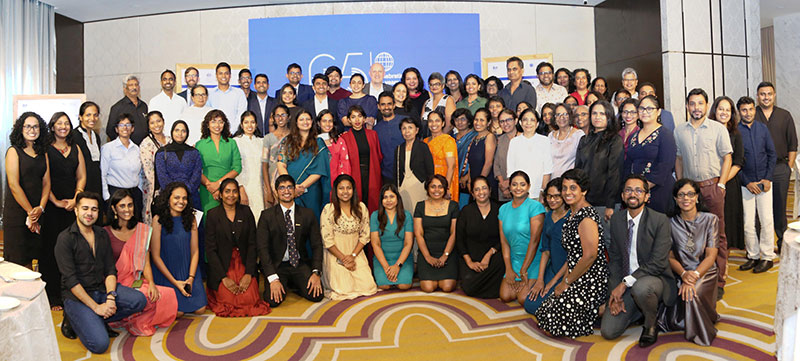
The British Council in Sri Lanka hosted its annual networking event to welcome home the latest batch of Sri Lanka’s Commonwealth and Chevening Scholars returning from the UK on completion of their studies.
This year’s event, organized together with the British High Commission Colombo, was also the 65th anniversary of the Commonwealth Scholarships, and took place on Commonwealth Day—the first-ever “Welcome Home” event that celebrated both Commonwealth and Chevening Scholars. The scholarships enable outstanding emerging leaders from all over the world to pursue advance studies in the UK.
HE Andrew Patrick, British High Commissioner, Orlando Edwards, Country Director of British Council Sri Lanka, and Philip Everest, Policy Lead from the Foreign, Commonwealth & Development (FCDO) Commonwealth & Marshall Scholarship Unit, together with Commonwealth and Chevening Scholarship alumni attended.
Commonwealth Day was celebrated across 56 Commonwealth member countries on 10March under this year’s theme ‘Together We Thrive’, demonstrating how working together can build a future defined by opportunity and resilience. During his Commonwealth Day Message, His Majesty The King, Head of the Commonwealth stated, “The Commonwealth’s ability to bring together people from all over the world has stood the test of time and remains as ever-important today.
-

 News6 days ago
News6 days agoSeniors welcome three percent increase in deposit rates
-

 Features6 days ago
Features6 days agoThe US, Israel, Palestine, and Mahmoud Khalil
-

 News6 days ago
News6 days agoScholarships for children of estate workers now open
-

 Foreign News5 days ago
Foreign News5 days agoBuddhism’s holiest site erupts in protests over Hindu ‘control’ of shrine
-
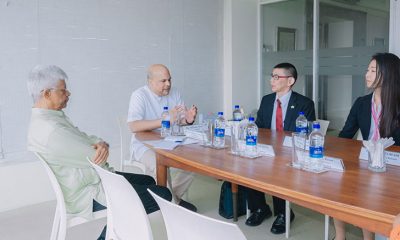
 News6 days ago
News6 days agoJapanese Defence Delegation visits Pathfinder
-

 Features3 days ago
Features3 days agoCelebrating 25 Years of Excellence: The Silver Jubilee of SLIIT – PART I
-

 Editorial5 days ago
Editorial5 days agoWhen tractors become cars!
-
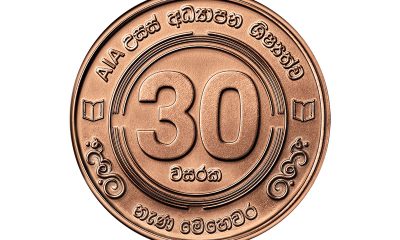
 Business1 day ago
Business1 day agoAIA Higher Education Scholarships Programme celebrating 30-year journey









